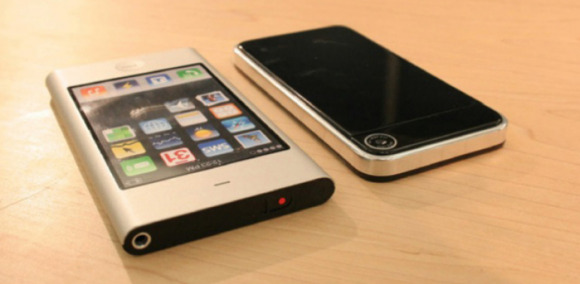iPhones with curved glass and extruded metal sized up in Samsung trial
Fans of the design process behind the most famous smartphone of all, the iPhone, are finding that the Apple vs Samsung trial taking place this summer is a treasure trove of visual clues on how the device came to be what it is today. What we're seeing today is an unearthed (by Network World) deposition by former Apple designer Douglas Satzger which lets the world know of a couple previously under-wraps early versions of the iPhone. One of these prototype devices had two panes of reinforced curved glass – one on the front, one on the back.
As it turns out, the curved glass iPhone was scrapped mainly due to money concerns as the technology in glass at the time was not up to par with what Apple needed to create a successful phone. With two pieces of curved glass popping up on both sides of the phone you've also got to think about the ease in which the device could break – that's an issue as well.
"The technology in shaping the glass, the cost relative to shaping the glass at the time, and some of the design features of this specific shape were not liked... The technology at the time had a lot to do with it. The qualities of the glass at the time had a lot to do with it. These are models — I'm trying to remember a time frame — that were before gorilla glass and before a lot of the other factors." – Satzger
As for how the fragility of the glass would be a factor, Stringer let it be known that drop tests were indeed done on all models. He makes certain to note, for whatever reason, that the drop tests done on the iPhone models throughout the process did not have much of an effect on the final design. The "shape" did not change as a result of the drop tests, he says, and each of the various forms were indeed dropped.
"It changed as a result of those fine-tuning the design. From a composition point of view, we were trying to decide how much of a border we wanted around the glass, the angles, the dimensions, the corner radii. We excruciatingly put through how we wanted this thing to appear. So yes, it did take various forms along the way... I can tell you quite plainly that this shape is not determined as a result of drop tests." – Satzger

The second model detailed a bit more today was an Extruded Aluminum prototype which you can see above on the right. This model looks rather similar to what we've seen in the iPhone 4/4S here in the final product universe, but it ultimately had to be scrapped for a variety of reasons. When asked whether this model, amongst other iPhones with bezels, were studied to determine which configurations best protect the display from cracking or breaking, Satzger had the following to say:
"We made prototypes of the product that included the bezel, and yes, they were dropped. But from an appearance point of view, the design, if you will, it remained unchanged in any significant way through the process." – Satzger
And so the iPhone "look" was born. But have a bit of a closer look at Satzger's talk on the extruded metal model and find how it diverged from the iPods at the time as well. Note how a "full metal jacket" was considered as well.
"To get the extruded aluminum design that was applied to the iPod to work for the iPhone, there were too many added features to allow it to be comfortable and to work properly... If you put an iPod up to your ear, the sharp edges, because of the processes, aren't comfortable, and you can't get antennas to work properly in a fully enclosed metal jacket. So each one of those things needed to apply other features that started." – Satzger
Have a peek at the timeline below to follow along with the Apple vs Samsung trial over the past week, and stick with SlashGear as we continue to dig in with the case as it expands through the future as well.
